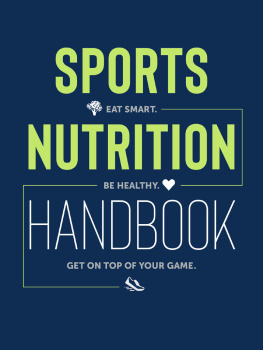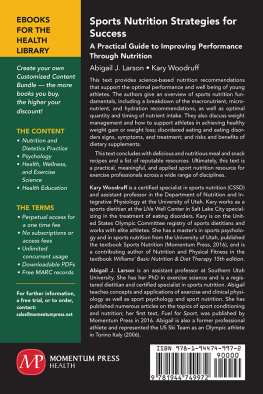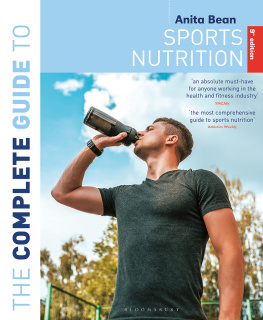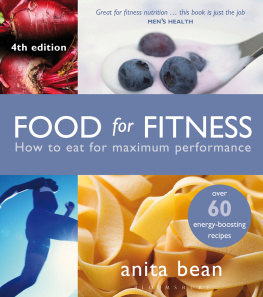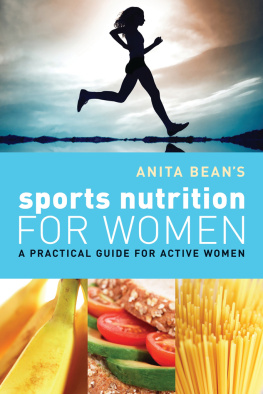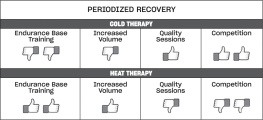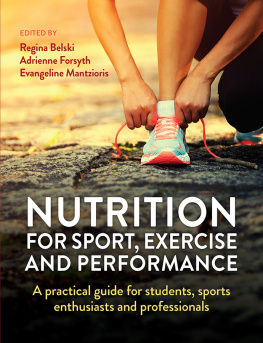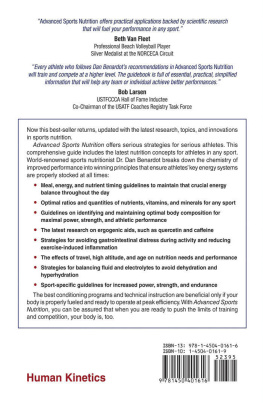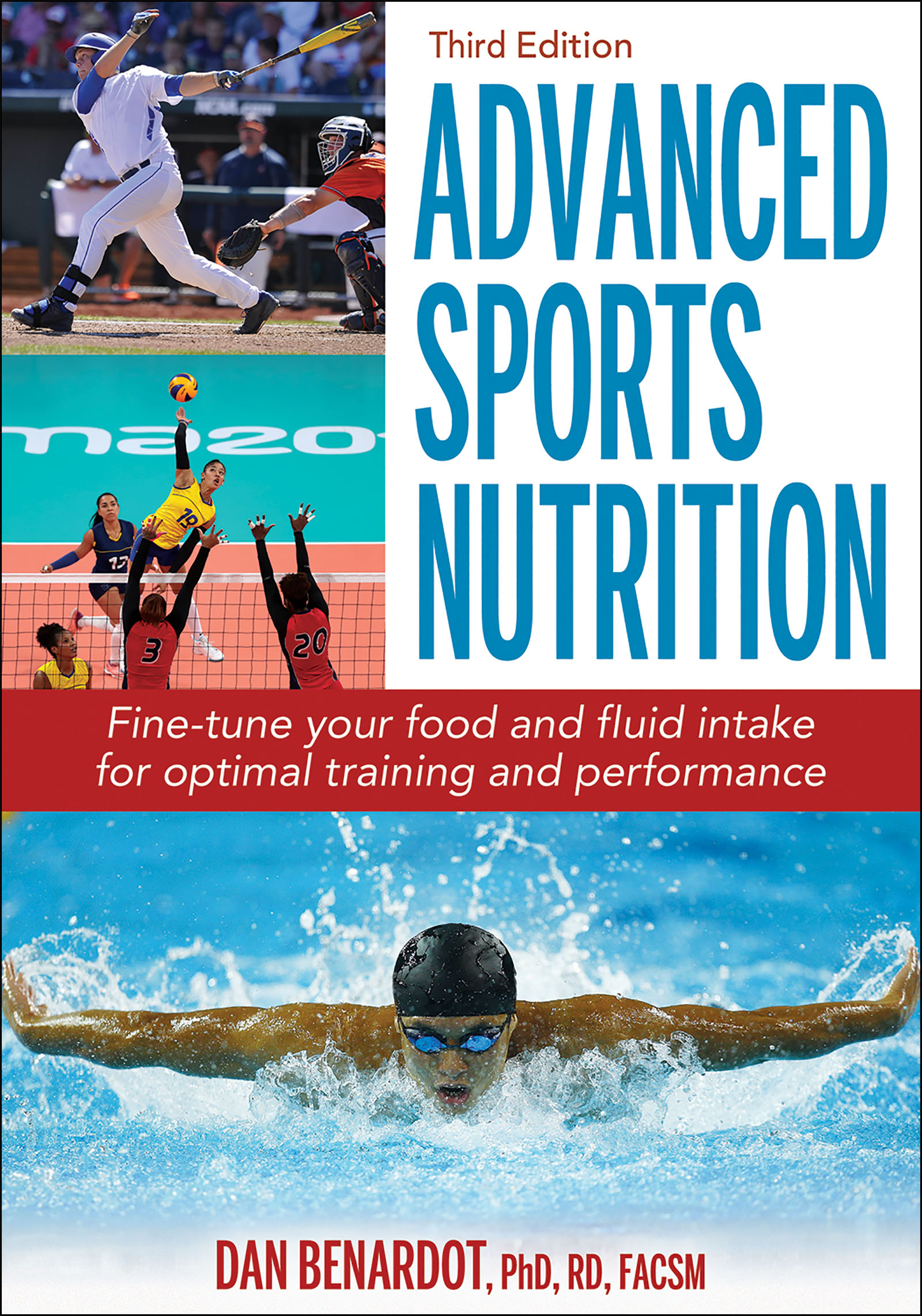Contents
Guide
Pagebreaks of the print version
Third Edition
Advanced Sports Nutrition
Dan Benardot
PhD, DHC, RD, LD, FACSM
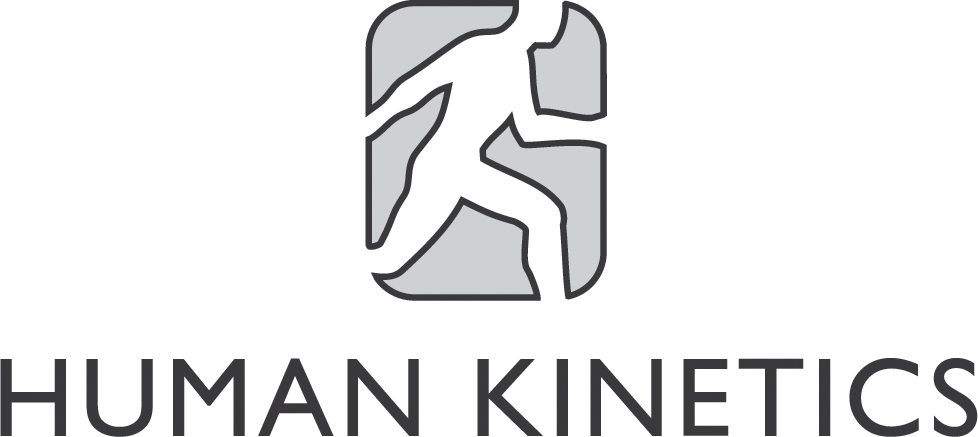
Library of Congress Cataloging-in-Publication Data
Names: Benardot, Dan, 1949- author.
Title: Advanced sports nutrition / Dan Benardot, PhD, DHC, RD, LD, FACSM.
Description: Third edition. | Champaign, IL : Human Kinetics, [2021] | Includes bibliographical references and index.
Identifiers: LCCN 2020023444 (print) | LCCN 2020023445 (ebook) | ISBN 9781492593096 (paperback) | ISBN 9781492593102 (epub) | ISBN 9781492593119 (pdf)
Subjects: LCSH: Athletes--Nutrition.
Classification: LCC TX361.A8 B45 2021 (print) | LCC TX361.A8 (ebook) | DDC 613.2/024796--dc23
LC record available at https://lccn.loc.gov/2020023444
LC ebook record available at https://lccn.loc.gov/2020023445
ISBN: 978-1-4925-9309-6 (print)
Copyright 2021, 2012, 2006 by Dan Benardot
Human Kinetics supports copyright. Copyright fuels scientific and artistic endeavor, encourages authors to create new works, and promotes free speech. Thank you for buying an authorized edition of this work and for complying with copyright laws by not reproducing, scanning, or distributing any part of it in any form without written permission from the publisher. You are supporting authors and allowing Human Kinetics to continue to publish works that increase the knowledge, enhance the performance, and improve the lives of people all over the world.
Notwithstanding the above notice, permission to reproduce the following material is granted to persons and agencies who have purchased this work: pp. 430-443.
This publication is written and published to provide accurate and authoritative information relevant to the subject matter presented. It is published and sold with the understanding that the author and publisher are not engaged in rendering legal, medical, or other professional services by reason of their authorship or publication of this work. If medical or other expert assistance is required, the services of a competent professional person should be sought.
The web addresses cited in this text were current as of March 2020, unless otherwise noted.
Senior Acquisitions Editor: Michelle Maloney; Developmental Editor: Laura Pulliam; Managing Editor: Hannah Werner; Copyeditor: Heather Gauen Hutches; Indexer: Beth Nauman-Montana; Permissions Manager: Dalene Reeder; Graphic Designers: Whitney Milburn and Dawn Sills; Cover Designer: Keri Evans; Cover Design Specialist: Susan Rothermel Allen; Photographs (cover): Raul Sifuentes/Getty Images; Dennis Hubbard/Icon Sportswire/Corbis/Icon Sportswire via Getty Images; Richard Heathcote/Getty Images; Photographs (interior): Photos on M. Anthony Nesmith/Icon Sportswire via Getty Images; Photo Asset Manager: Laura Fitch; Photo Production Manager: Jason Allen; Senior Art Manager: Kelly Hendren; Illustrations: Human Kinetics, unless otherwise noted; Printer: Sheridan Books
Human Kinetics books are available at special discounts for bulk purchase. Special editions or book excerpts can also be created to specification. For details, contact the Special Sales Manager at Human Kinetics.
Printed in the United States of America 10 9 8 7 6 5 4 3 2 1
The paper in this book is certified under a sustainable forestry program.
Human Kinetics
1607 N. Market Street
Champaign, IL 61820
USA
United States and International
Website: US.HumanKinetics.com
Email: info@hkusa.com
Phone: 1-800-747-4457
Canada
Website: Canada.HumanKinetics.com
Email: info@hkcanada.com
E7910

To my wife, Robin, who helps me in every imaginable way.
Contents
- Energy nutrients (carbohydrate, protein, and fat) are fuel sources for athletes, but they also have other functions, including muscle recovery and tissue repair. These substrates are metabolized differently depending on exercise intensity, substrate availability, and conditioned state. This chapter clarifies what substrates should be emphasized before, during, and after exercise.
- Physical activity alters the requirements for vitamins and minerals, with the type of activity performed in different environmental conditions having a different effect on utilization and need. This chapter demonstrates how the sporting discipline, age, and gender influence the risk of vitamin or mineral deficiency, and it recommends the best ways of ensuring that cellular needs are satisfied.
- Fluid and electrolyte balance is critically important for sustaining athletic performance, but it is difficult to accomplish without a hydration plan that is tailored to the athlete and the environmental conditions. This chapter provides information on how to create appropriate hydration strategies and how to help the body adapt to consumption of the right amounts of fluid.
- Nutritional ergogenic aids are substances that can improve athletic performance if properly consumed. However, there are many ergogenic aids available to athletes that fail to perform as advertised, and they may have a negative impact on performance. This chapter highlights the nutritional ergogenic aids that may benefit athletes in specific sports and those that should be avoided because of potential problems.
- Everything an athlete eats and drinks passes through the gastrointestinal (GI) tract, which is responsible for digesting foods so that vitamins, minerals, and energy substrates can be absorbed into the blood for delivery to tissues. This chapter focuses on how consuming the right foods and beverages at the right times and in the right amounts can help athletes optimize GI function and minimize the risk of GI distress.
- Nutrition recommendations have traditionally emphasized the foods and beverages that will meet daily nutritional needs. There is an increasing body of evidence highlighting the importance of eating and drinking those foods and beverages in the right amounts and at the right times. This chapter provides information on how the timing of consumption can influence athletic performance.
- Travel is a common aspect of the life of athletes, who often cross multiple time zones and travel to locations with different cultures and unfamiliar foods. This chapter provides information on the common nutritional problems that travel creates, with solutions for how to reduce travel-associated risks so that athletes can perform at their conditioned capacity.
- The lower oxygen level at high altitude has a negative impact on athletic performance in an athlete who has not adapted to the altitude. Staying at a high altitude for a period of time may create an adaptation that improves oxygen-carrying capacity and endurance. This chapter reviews the nutritional strategies to follow for enhancing adaptation in high-altitude environments.
- The nutritional requirements of athletes vary widely based on age and gender, and these differences must be taken into consideration to optimize health and athletic performance. This chapter reviews the common risks faced by athletes of different ages and genders, and examines how sports that emphasize appearance may be associated with nutritional risks that have a negative impact on performance and athlete longevity.


